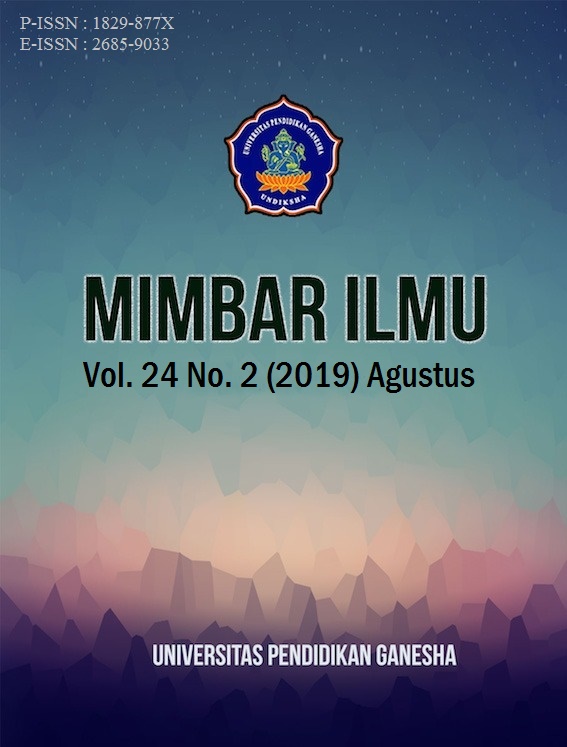PENGARUH PENGGUNAAN MEDIA ANIMASI SANDISKO DENGAN MODEL SOMATIC AUDITORY VISUALIZATION INTELLECTUALLY TERHADAP HASIL BELAJAR TEMA KEBERSAMAAN KELAS 2
DOI:
https://doi.org/10.23887/mi.v24i2.21288Abstract
Abstrak
Latar belakang penelitian ini adalah rendahnya hasil belajar kognitif pembelajaran tematik peserta didik kelas 2 SD Negeri Tambakrejo 01 Semarang. Sebesar 38,46% peserta didik yang telah mencapai Kriteria Ketuntasan Minimal (KKM). Hal tersebut disebabkan kurangnya variasi dalam penggunaan media dan model pembelajaran saat proses belajar mengajar. Penelitian ini bertujuan untuk mengetahui pengaruh media animasi SANDISKO dengan model Somatic Auditory Visualization Intellectually terhadap hasil belajar tema kebersamaan kelas 2 SD Negeri Tambakrejo 01. Jenis penelitian ini adalah penelitian adalah penelitian kuantitatif dalam bentuk desain quasi experimental design yang digunakan adalah bentuk nonequivalent control group design. Populasi dalam penelitian ini adalah seluruh peserta didik kelas 2 SD Negeri Tambakrejo 01 Semarang yang berjumlah 27 peserta didik yang terdiri dari kelas 2A dan 26 peserta didik dari kelas 2B dengan menggunakan teknik sampling jenuh. Hasil analisis data diperoleh nilai rata-rata pretest kelas eksperimen sebesar 68,65. Setelah diberi perlakuan nilai rata-rata posttest mengalami peningkatan menjadi 80,96. Data tersebut didukung oleh analisis menggunakan analisis regresi linier sederhana dengan r2= 0,541 jadi variabel x (media animasi SANDISKO dengan model SAVI) mempengaruhi variabel y (hasil belajar tema kebersamaan) sebesar 54,1%. Sehingga dapat disimpulkan bahwa media animasi SANDISKO dengan model Somatic Auditory Visualization Intellectually berpengaruh signifikan untuk meningkatkan hasil belajar tema kebersamaan kelas 2 SD Negeri Tambakrejo 01 Semarang.
Kata-kata kunci : Animation media, SAVI, learning outcomes
Abstract
The background of this study is the low cognitive learning outcomes of thematic learning in grade 2 students of SD Negeri Tambakrejo 01 Semarang. 38.46% of students have reached the Minimum Mastery Criteria (KKM). This is due to the lack of variation in the use of media and learning models during the teaching and learning to process. This study aims to determine the effect of SANDISKO animation media with Somatic Auditory Visualization Intellectually models on learning outcomes of the theme of togetherness class 2 Tambakrejo State Elementary School 01. This type of research is quantitative research in the form of quasi experimental design, design used is the form of nonequivalent control group design. The population in this study were all grade 2 students of SD Negeri Tambakrejo 01 Semarang, amounting to 27 students consisting of class 2A and 26 students from class 2B using saturated sampling techniques. The results of data analysis obtained the average value of the experimental class pretest of 68.65. After being given treatment the post test average value increased to 80.96. The data is supported by analysis using simple linear regression analysis with r2 = 0.541 so variable x (SANDISKO animation media with SAVI model) affects the variable y (learning outcomes of togetherness themes) by 54.1%. So it can be concluded that the animation media SANDISKO with the Somatic Auditory Visualization Intellectually model has a significant effect on improving the learning outcomes of the second grade togetherness theme at SD Negeri Tambakrejo 01 Semarang.
Keywords: Animation media, SAVI, learning outcomes
References
Ariasih, Ni Kdk., I.B .Gd.Surya Abadi, IGA. A.Sri Asri. 2014. “Pengaruh Model Pembelajaran Kooperatif SAVI Berbantuan Media Konkret Terhadap Hasil Belajar IPA SD”. e-Journal PGSD Universitas Pendidikan Ganesha Jurusan PGSD, 2(1).
Allo, R.A, Sugiarti, Salempa, P. 2017. “Pengaruh Penggunaan Media Animasi melalui Model Pembelajaran Inkuiri Terbimbing Terhadap Motivasi dan Hasil Belajar Peserta Siswa Kelas VII SMPN 30 Makassar (Studi pada Materi Pokok Karakteristik Zat)”. e-Journal Chemica Universitas Negeri Makassar, 18(2).
Depdiknas. 2003. Undang-undang RI Nomor 20 Tahun 2003 tentang Sistem Pendidikan Nasional.
Falahudin, Iwan. 2014. Pemanfaatan Media dalam Pembelajaran. Jurnal Lingkar Widyaiswara Edisi 1 No. 4, Oktober – Desember 2014
Jakni. 2016. Metodologi Penelitian Eksperimen Bidang Pendidikan. Bandung: Alfabeta.
Mahnun, Nunu. 2012. MEDIA PEMBELAJARAN (Kajian terhadap Langkah-langkah Pemilihan Media dan Implementasinya dalam Pembelajaran) . Jurnal Pemikiran Islam; Vol. 37, No. 1 Januari-Juni 2012
Omeri, Nopan. 2015. Pentingnya Pendidikan Karakter Dalam Dunia Pendidikan . Jurnal Manajer Pendidikan, Volume 9, Nomor 3, Juli 2015,
Setiyani, A dan Priyanto, W. 2017. “Analisis Serial Animasi Upin dan Ipin pada Perkembangan Afektif Siswa Kelas III”. e-Journal Sekolah Universitas Negeri Medan, 2(1).
Shoimin, Aris. 2017. 68 Model Pembelajaran Inovatif dalam Kurikulum 2013. Yogyakarta: Ar-Ruzz Media.
Subekti, E.E dan Sukamto. 2018. Statistika Penelitian. Semarang.
Sugiyono. 2013. MetodePenelitian Pendidikan (Pendekatan Kuantitatif, Kualitatif dan R&D). Bandung: CV. Alfabeta.
Sugiyono. 2018. Metode Penelitian Kuantitatif. Bandung: Alfabeta.
Susanto, Ahmad. 2013. Teori Belajar & Pembelajaran di Sekolah Dasar. Jakarta: Prenadamedia Group.
Downloads
How to Cite
Issue
Section
License
This work is licensed under a Creative Commons Attribution-ShareAlike 4.0 International License.
Authors who publish with this journal agree to the following terms:
- Authors retain copyright and grant the journal right of first publication with the work simultaneously licensed under a Creative Commons Attribution-ShareAlike 4.0 International License that allows others to share the work with an acknowledgment of the work's authorship and initial publication in this journal.
- Authors are able to enter into separate, additional contractual arrangements for the non-exclusive distribution of the journal's published version of the work (e.g., post it to an institutional repository or publish it in a book), with an acknowledgment of its initial publication in this journal.
- Authors are permitted and encouraged to post their work online (e.g., in institutional repositories or on their website) prior to and during the submission process, as it can lead to productive exchanges, as well as earlier and greater citation of published work.





